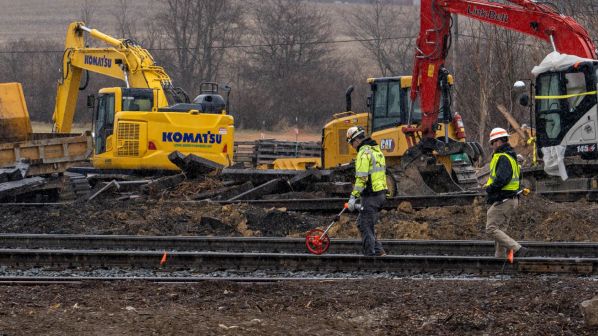THE Association of American Railroads (AAR) has issued an update on the measures undertaken by the Class 1 freight railways to improve safety in the 12 months since the devastating derailment of a Norfolk Southern (NS) freight train in East Palestine, Ohio, on February 3 2023.
The derailment of 50 wagons, which were carrying vinyl chloride and a variety of other freight, caused a massive fire and the evacuation of a large area. The source of the derailment and initial fire were traced to an overheated axle on one of the wagons.
AAR describes the action by US freight railways to help prevent similar accidents from occurring as “quick and decisive,” adding that the Class 1s have “kept and in some cases exceeded their promises.”
The steps taken:
• increase the number of hot bearing detectors (HBDs) across key routes: AAR says the Class 1s have purchased and installed hundreds of additional HBDs, with more to come online in 2024. These HBDs are complemented by additional existing and evolving technologies targeted at effectively identifying bearing defects.
• establishing a new industry standard of stopping and inspecting trains when an HBD reading exceeds 77°C, which compares with the previous standard of 93°C. The standard became effective on July 1 2023.
• introducing a new, industry-wide trending analysis rule. This is informed by Railinc’s comprehensive analysis of 150 algorithms used by the Class 1s to pinpoint the most effective algorithm for detecting problematic bearings. It went live on November 29 2023.
• train 20,000 first responders in local communities and 2000 at the Security and Emergency Response Training Centre (SERTC) in Pueblo, Colorado: the Class 1s trained 35,500 first responders last year.
• double the number of first responders with access to AskRail, which provides real-time information on wagon contents and the safe handling of those materials: AAR says the railways have dramatically exceeded this goal with AskRail information now available to more than 2.3 million first responders across the US and Canada
• identify ways to improve the fire performance of tank cars and other equipment: AAR’s tank car committee issued new recommendations for bottom valve protection requirements to increase safety. This is a voluntary joint initiative between the industry and shippers of hazardous materials that own the tank cars. AAR says the committee is continuing to explore other engineering solutions capable of safely and reliably addressing this issue.
• supplementing the railway’s existing confidential incident reporting programmes by joining the Federal Railroad Administration’s (FRA) voluntary C3RS programme: AAR admits that this process “has not moved as quickly as we would prefer,” but says the railways remain committed to joining the C3RS programme and have participated in several FRA Railroad Safety Advisory Committee (RSAC) meetings. NS was confirmed as the first Class 1 to participate in a pilot on January 29.
NS has committed more than $US 103m to support recovery in East Palestine and the surrounding areas.
Legislation
AAR says these efforts have been voluntary, and show the “industry’s commitment to lead, innovate, and implement tangible safety solutions without waiting for mandates from Congress or regulators.” However, it says the railways are “fully committed to working with the Commerce Committee and all members of the Senate” to advance the Railway Safety Act.
This legislation was introduced in May and aims to address requirements for rail operators and trains transporting hazardous materials. It has so far not received any amendments as the bill’s proponents seek support in the US Senate.
AAR says the railways are continuing discussions s to address what it sees as five problematic aspects of the bill, including the lack of cost:benefit analysis and mandatory train crewing requirements.
“The industry has provided substantive feedback on changes that would improve safety outcomes, encourage future safety technology advances and avoid negative consequences for the supply chain,” AAR says.
“Railroads will continue good-faith efforts with policymakers to find a path for common-sense legislation that can help prevent an incident like the one in East Palestine.”
“Rail freight rail is and remains a safe, responsible way to move the hazardous materials America requires. While there is still more work to do, the industry continues to prioritise ongoing improvements to safeguard our people and our communities.”
Norfolk Southern initiatives
A NS freight train passing through East Palestine.
NS has also published details of the actions it has taken to support the East Palestine community in the 12 months since the accident.
The Class 1 says it has “made significant progress” and is now focused on long-term initiatives to address health concerns, protect property values, and safeguard local drinking water. It has committed more than $US 103m to projects in East Palestine and the surrounding areas in Ohio and Pennsylvania.
“From the beginning, we pledged to do the right thing in East Palestine and other areas affected,” says NS president and CEO, Mr Alan Shaw. “But our job here is bigger than doing just one right thing. It’s about doing the next right thing, and the next one after that. The road to recovery is just the start; we’ll be here as long as it takes for these communities to truly flourish.”
The post AAR highlights Class 1 efforts to improve freight safety following East Palestine derailment appeared first on International Railway Journal.

